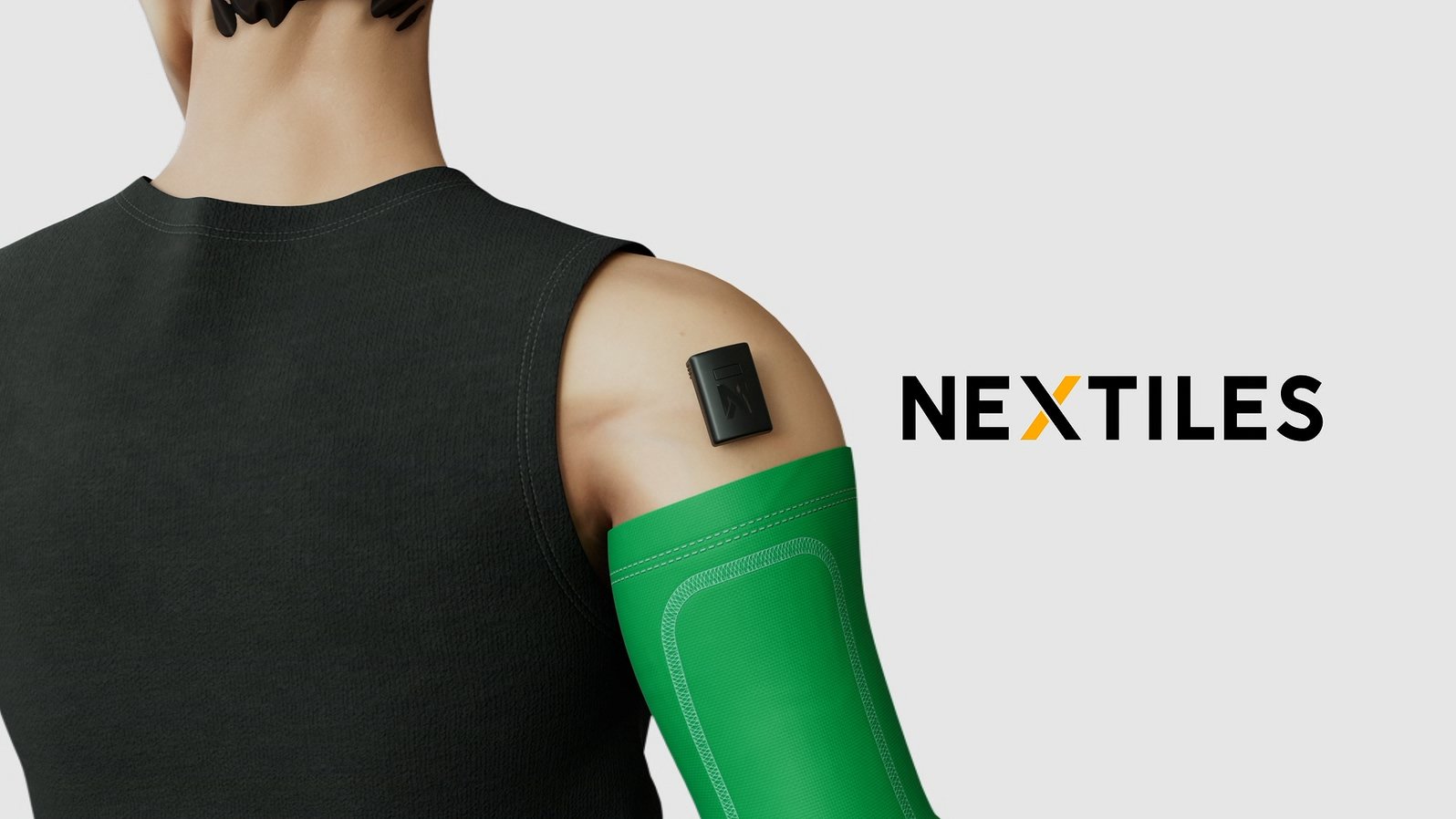Once, wearable tech meant bulky wristbands and blinking gadgets. Now, in 2025, smart fabrics are ushering in a quiet revolution. Take the latest biomechanic compression gear from Nextiles, it looks and feels like premium sportswear, but it’s embedded with conductive threads that track joint motion in real time. This isn’t niche gear for Olympic athletes. It’s hitting consumer shelves and gym lockers alike.
These smart fabrics are redefining what wearable tech looks like. They’re soft, breathable, washable, and flexible enough to stretch with a yoga pose or a sprint.
Unlike rigid smartwatches or clunky chest straps, smart textiles gather more localized data across the entire body, without compromising comfort. Simply put, they’re turning clothing into the most intuitive sensor platform we’ve ever worn.
And this time, it’s not about accessories. It’s about fabric itself.
What Conductive Textiles Actually Are (And How They Work)
Smart fabrics, also known as e-textiles, are textiles woven or coated with materials that can conduct electricity. Think silver-coated threads, carbon-infused yarns, and graphene textiles, materials capable of carrying current without adding stiffness or bulk.
Embedded into garments, these fibers act as sensors that detect changes in motion, pressure, temperature, and even bioelectrical signals like heart rate variability or skin conductivity.
A compression sleeve might register shoulder rotation speed. A pair of leggings could map quad activation mid-sprint.
Once captured, this sensor data travels to a compact control unit, usually a flexible printed circuit, before syncing wirelessly with a paired app. From there, users can review metrics or stream real-time feedback. The setup is low-profile, often weighing less than 20 grams total, and can be hidden within linings or hems.
The most promising innovations are those that prioritize textile integrity. Researchers at NC State University, for example, have developed knitted strain sensors that stretch like spandex while offering pinpoint data resolution. This level of material flexibility ensures that performance tracking doesn’t come at the cost of natural movement or wearability.
Where They’re Already Showing Up

Smart fabrics have quietly entered commercial reality. The tech isn’t hypothetical anymore, it’s wearable today.
Nextiles makes smart sleeves and shirts that track athletic performance with sub-millimeter accuracy. NBA teams have tested them to fine-tune player mechanics and injury recovery programs.
Xenoma offers e-skin garments used in physical rehab and motion capture, including shirts that stream live skeletal tracking for VR integration or recovery diagnostics.
Loomia focuses on layering interactive electronics into clothing for heating, lighting, and even tactile feedback. Their soft circuit systems have appeared in both fashion-forward collaborations and industrial wearables.
Myant’s SKIIN line offers biometric underwear that monitors heart rate, breathing, and stress patterns, specifically aimed at health-conscious consumers who want long-term insight without strapping on new hardware.
In some cases, these garments are already deployed in military testing for fatigue detection or integrated into hospital trials for post-op mobility rehab. Major fashion and athletic brands, like Under Armour and Nike, have filed patents related to similar technology.
Wearables integrated with smart textiles are also seeing traction in elder care. In pilot studies across Europe, garments equipped with pressure sensors have been tested to reduce fall risks by alerting caregivers to gait instability in real time. These applications demonstrate that smart fabrics are not just novelties, they’re part of a practical solution ecosystem.
And if current research trajectories hold, some of these garments may also support integrated micro-screens or projectors. Imagine a hoodie that not only tracks your posture but displays your live vitals on your sleeve, or even projects browser windows or app interfaces onto a nearby wall.
This convergence of smart textiles with display tech could create a new genre of wearable interactivity. While these technologies are still early-stage, researchers at institutions like MIT’s Self-Assembly Lab and the Max Planck Institute have prototyped stretchable displays and textile-integrated illumination systems capable of low-res dynamic output.
Now imagine using these interfaces to interact with lightweight, web-optimized platforms, like mini news feeds, workout instructions, or browser-based games. One example is Bet Zillo, a mobile-first iGaming platform optimized for ultralight HTML5 delivery. While not specifically designed for smart fabric interaction, its low-latency slots and sportsbook features could be adapted to future ambient browsing environments, particularly where hands-free, glanceable UX is a priority.

Why Smart Fabric > Smartwatch for the Next Phase
Smartwatches and rings were great first steps, but they cover limited real estate and can only capture so much. Smart fabrics change the scale entirely.
For one, they collect data across large muscle groups, not just pulse points. A smart shirt can measure left-right balance in your shoulders. A sock can track asymmetry in foot pressure. This makes the data far richer and more actionable.
Second, smart fabrics are wearable by design. No daily charging ritual. No forgetting to put it on. The tech blends into clothes you already wear, undergarments, compression gear, leisurewear—and works in the background.
Third, gesture control is made possible. Instead of tapping buttons, users can control functions through subtle finger movements or posture cues detected via textile interfaces. This is especially promising for augmented reality or accessibility tech.
A growing body of evidence shows these advantages aren’t just theoretical. A 2024 study published in Sensors and Actuators A found that athletes using smart textiles for training improved form retention by 18% over a six-week period, compared to only 5% for those using conventional fitness trackers. That kind of delta points to a future where smart textiles aren’t just an alternative, they’re the preferred tool.
Challenges Holding It Back (So Far)
For all their promise, smart fabrics aren’t mass-market yet. Several hurdles remain.
Durability is a major one. Conductive fibers can fray or lose efficiency after repeated wash cycles. Though hydrophobic coatings and encapsulated circuits help, manufacturers are still chasing industrial-level robustness.
Power supply remains a delicate balancing act. Battery integration must stay featherlight, flexible, and safe. Some brands use thin film batteries or kinetic energy harvesters, but energy storage is still the bottleneck.
Data privacy is another friction point. Clothing that monitors sleep, stress, and activity inevitably collects sensitive health info. As these garments become mainstream, privacy legislation and user consent frameworks will have to catch up.
Cost is also a concern. While prices are falling, premium smart garments still run significantly more than their non-smart counterparts. But like all tech, scale helps. As demand grows, affordability should follow.
You’ll Wear It Before You Know It
The best tech disappears. That’s the ethos behind smart fabrics.
They’re not meant to be flaunted or fussed with. They’re designed to vanish into your wardrobe, quietly enhancing your body’s communication with the systems you trust.
In a few years, your shirt might adjust your sleep schedule, your socks might tweak your running form, and your favorite hoodie might help you manage stress. And you won’t have to press a single button to make it happen.
Smart fabrics aren’t replacing wearables. They are the next evolution of wearables. Sleek, invisible, and always in tune with the most important system of all: you.

